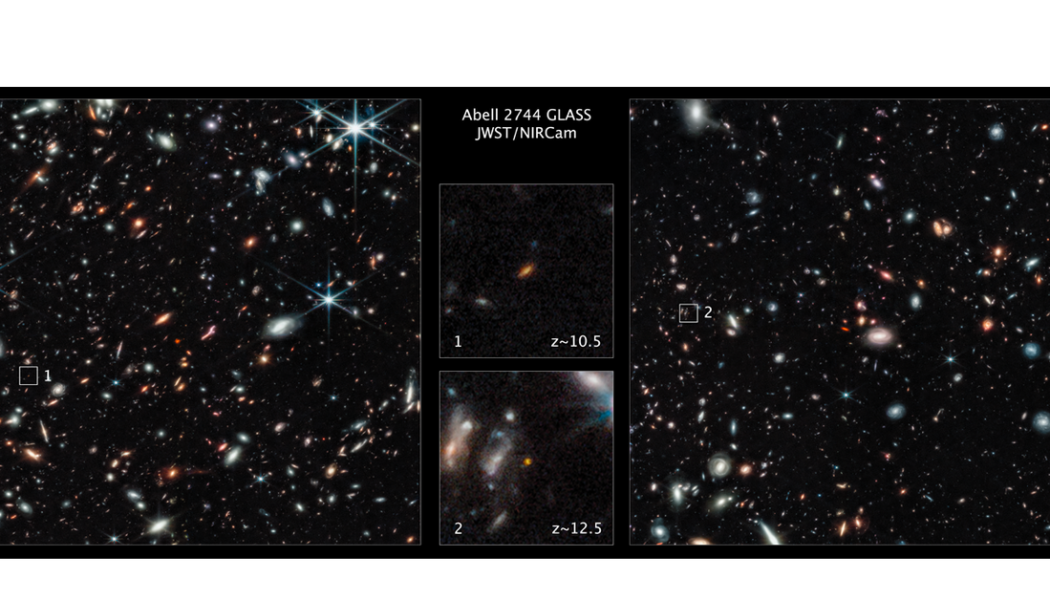/cdn.vox-cdn.com/uploads/chorus_asset/file/24206562/STScI_01GG7S6RANFE43ABCW247D55HZ.png)
Researchers using the James Webb Space Telescope have found two extremely old galaxies from just 300 to 400 million years after the Big Bang. These galaxies are far brighter than expected, causing astronomers to question what they know about how galaxies formed when the universe was young.
“Somehow, the universe has managed to form galaxies faster and earlier than we thought,” said Tommaso Treu, principal investigator for one of JWST’s programs (GLASS-JWST), in a press briefing.
The most distant galaxy identified, called GLASS-z12, is thought to be from 350 million years after the Big Bang. The galaxies were identified in two JWST programs, the GLASS-JWST Early Release Science Program (Grism Lens-Amplified Survey from Space) and Cosmic Evolution Early Release Science Survey (CEERS). Data from these surveys identified galaxies that have high redshift, meaning that the light coming from them is shifted to the red end of the spectrum due to the expansion of the universe. The greater the redshift, the further the light has traveled before reaching us, hence the older the galaxy.
The greater the redshift, the further the light has traveled before reaching us
To identify the oldest galaxies, researchers start by looking at images taken by JWST and selecting galaxies of interest based on their color. They look for galaxies that don’t appear in the visible light wavelength but do appear in JWST’s infrared range. That implies that a galaxy is redshifted so much that its light has moved out of the visible light range, making it potentially a very early galaxy.
The challenge is that there are other reasons that a galaxy might not appear in visible light images. For example, optical light can be blocked by dust, or a galaxy could just be unusually red. To confirm that a given galaxy really is very old, we need more data in the form of spectroscopy.
“Getting a spectrum of the source, when we see emission lines from different elements, it really tells us exactly what we’re looking at,” said Jeyhan Kartaltepe, co-investigator for CEERS. “So that’s the gold standard we need to head towards.”
The two recently announced galaxies haven’t yet been confirmed with spectroscopic measurements, but the most distant galaxy has been tentatively confirmed with data from ALMA, the Atacama Large Millimeter/submillimeter Array. Garth Illingworth, co-investigator for the First Reionization Epoch Spectroscopic Complete and Public Release IMaging for Extragalactic Research galaxy surveys, said they were confident about their findings: “There have been lots of preliminary announcements of even earlier galaxies, and we’re still trying to sort out as a community which one of those are likely to be real,” Illingworth said. “We feel very confident about these two, but less confident about the others.”
There has been some back and forth among researchers about the accuracy of early data from JWST as calibrations are refined. Some of the very early results publicized galaxies with redshifts as high as 13, but this number has now been refined down to 12.5 with more accurate calibrations. This was because the earliest data was based on calibrations performed on the ground, while the more recent data reflects calibrations done while the telescope was in space in October. Calibrating JWST’s instruments is a lengthy process, and readings will get more accurate as time goes on.
As well as confirming the findings, gathering spectroscopy data on these targets will give a more in-depth look at the content of early galaxies. “It’s like using a prism, and we are able to see the fingerprints of the different atomic elements that have different colors in the spectrum of the galaxy,” GLASS-JWST co-investigator Alaina Henry explained. “So we get much more detailed information about the contents of galaxies, the rates that they’re forming stars, and the motions of the gas.”
For now, the extreme brightness of these early galaxies is causing astronomers to rethink their assumptions about the earliest stars. While galaxies that are very bright are usually very massive, it could be that these early bright galaxies aren’t that massive — they’re just full of Population III stars. Population III stars are still hypothetical, but the idea is that they are among the earliest stars which have different compositions than the stars we see today. “This is opening up a whole question about the nature of stars and how they form, and the type of stars that form in the very early times,” Illingworth said.








